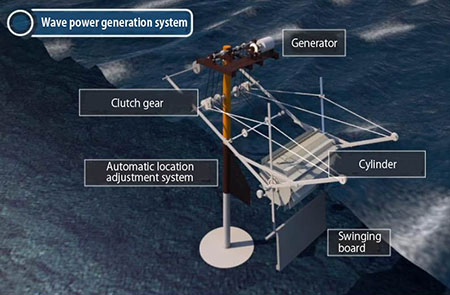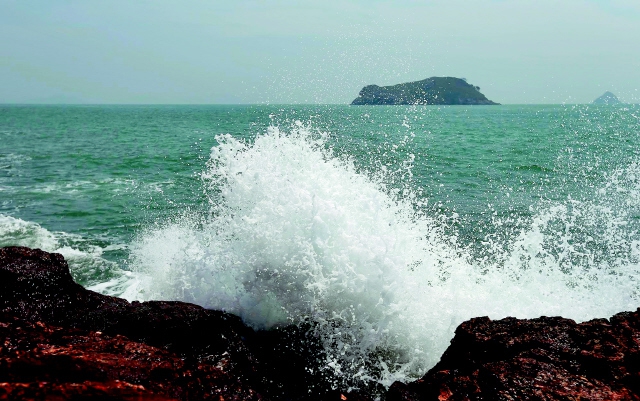Cylinder and swing board enable electricity production under any conditions
In a recent article in the journal Nature Communications, a US research team noted that global warming has resulted in an annual increase in the amount of wave energy in the world’s oceans. Based on an analysis using satellite altimeter data and computer modeling, the research team from the University of California, Santa Cruz, concluded that global wave energy had increased by an average of 0.47% each year since 1948, and 2.3% over the past two decades or so. The findings suggest that if the waves can be harnessed as an energy source, global warming could end up bringing benefits rather than losses. Surrounded on three of its sides by water, South Korea boasts a veritable treasure trove of renewable energy in its waves.
The wave energy endowment of South Korea’s coastal regions is estimated at around 6.5GW. If more distant waters are used, it is seen as capable of producing up to 50GW of electricity – the equivalent of 50 nuclear reactors. Developing even just 5% of the wave energy along the coasts of Jeju Island (roughly 2,000MW) would create enough electricity for 35,000 households. In contrast with tidal power generation, which involves building estuary embankments and using only the difference between high and low tide, wave power offers the advantage of being eco-friendly, with almost no impact on the marine ecosystem and environment.
Historically, roughly a dozen countries – mostly in Europe – have been developing various wave power systems for over a century, including the UK, the Netherlands, and Denmark. But no country has yet commercialized it, due to the steep early installation costs and the higher power generation costs compared to other renewable energies. The different forms of wave power systems include the moving body type, which uses an object that moves with the waves; the oscillating water column type, which uses wave-based oscillations on the ocean surface to operate a turbine through the compression and expansion of air in an enclosed space; and the overtopping type, which utilizes a water wheel as waves pass over an obliquely positioned structure.
 |
|
New wave power generation system
|
But actual examples of smoothly functioning wave power in the test operation stages can be found in just five countries worldwide, including South Korea. Even the wave power generation system that was tested in Jeju ended up inundated due to unknown causes late last year. Wave power further faces similar limitations to solar and wind power: just as those two approaches only work when the sun is shining and the wind is blowing, respective, so wave power can only generate electricity when waves are moving.
Recently, a research team from the Korea Institute of Civil Engineering and Building Technology (KICT) announced the development a new concept in wave power systems, which overcomes the aforementioned problems to allow for stable power generation 24 hours a day. The key devices in the system, which was the developed by the team of KICT Department of Infrastructure Safety Research under Park Min-su, senior research fellow, are its dual conversion device and automatic position adjustment device.
Same principle as a bicycle pedal
“We got the idea for the dual conversion device from the structure and principle of a bicycle pedal,” explained Park.
“In a wave, the direction of the water molecules’ circular motion changes as they go from the wave’s peak to its trough and back to its peak again. So if you place a water mill on the waves, its direction will change,” he said.
“When you’re riding a bicycle and the wheels are turning quickly, they’re going to spin idly when you push the pedals in the opposite direction. We’re using that to get the movement to turn in one direction,” he explained.
With the dual conversion device, the loss of wave power can be minimized. The waves in the sea move 24 hours a day. They rise higher when the wind is more intense and sink lower when the wind dies down. The devices responsible for power generation in the team’s wave power system are its cylinder and swing board. The cylinder draws energy from the waves’ circular motion, the swing board from their linear movement. That energy is used to turn a turbine and generate electricity. The team initially envisioned installing the two devices separately.
But the electricity produced in such a case is not transported to the outside but rather flows from sites with high power generation to sites with low power generation. When the researchers realized this, they altered their approach by combining the two devices and setting the dual converter to select and activate the device with a higher rate of power generation every second. The cylinder is used to generate power when the waves are high, and the swing board is used when the waves are low. The principle here is similar to a hybrid automobile that increases efficiency by selectively alternating between electricity and the internal combustion engine as its source of power.
The automatic location control device uses the principle of buoyancy to raise and lower the entire system as the depth of the water changes. The device is also designed to enable free horizontal rotation according to the direction of the waves.
“This system is designed to produce electricity under any conditions, regardless of the water level or the tidal range. This makes it possible to produce power constantly even though the waves change in intensity and direction many times a day,” Park said.
After building a pilot wave power generation system equipped with these devices, the research team tested it at the marine science aquarium at the Yeosu Campus of Chonnam National University under the condition of waves measuring 1m high and recurring on a 1-second period. The electricity generated was measured at 3kW per hour. This is the amount of electricity that a South Korean household consumes on average in a single month. The generating efficiency, which compares the energy inputted to the energy produced, was found to be an average of 24.1% an hour. This compares positively to a pendulum-style floating wave power generator by a research team at France’s National Center for Science Research (CNRS) that was found to have a maximum generating efficiency of just 12%. In terms of generating efficiency, at least, the KICT research team’s system scored more than twice as high.
“Our system is comparable to a small wind turbine in terms of the cost of building and installing the generator. But whereas a wind turbine requires an area that’s five times larger than the diameter of its blades, this new wave power generation system can be installed right next to other units. By installing the system on the coast and near islands, it can not only resolve the issue of power transmission but can also be used as a tourism resource through beautiful design,” Park said.
By Lee Keun-young, senior staff writer
Please direct comments or questions to [english@hani.co.kr]










